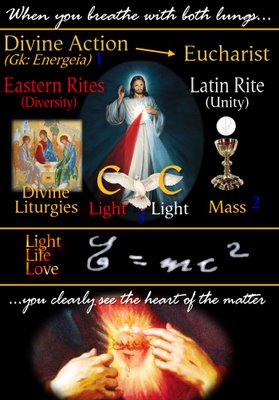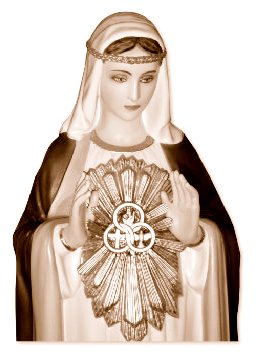Another Reflection on Transubstantiation and Einstein from the web
Edited on Sun Feb-06-05 04:23 AM by Stunster
The Eucharist is a mystery, and I admire Aquinas greatly for being able to come up with any explanation at all.
According to Aristotle, substance can be understood as the 'to ti en einai' of a thing--literally, 'the what it was to be' of the thing.
Having said that, Aristotle appears to give two somewhat different accounts of substance, one in the Categories, and another in the Metaphysics.
The substance of something, then, is the answer to the question, "What is it?" (as in, "It's a cat", or "It's a dog"). But in the Categories sense of substance, one can also answer this question by saying it's a particular individual, as in, "It's Socrates."
Hence, I take transubstantiation to mean that the 'correct answer' to the question "What is it?" before the Eucharistic consecration is "bread" (or "wine"), and that after the consecration, the correct answer is "Jesus Christ". In other words, the "what it is to be" of the Eucharistic species has changed.
Of course, empirically, nothing has changed. As Aquinas puts it, the 'accidents' remain the same---meaning the accidental properties of the Eucharistic species are unchanged. But what it essentially is has changed.
Normally, it's a thing's accidental properties that change, and what it essentially is does not change. A baby becomes over time an old man, but is still the same human person. With transubstantiation it's the other way round. I suppose that if we can grasp the fact that a baby becomes an old man but remains the same human person, then we ought to be able to grasp the fact that a piece of bread retains the same appearance but is no longer bread at all. But of course, the latter seems much more difficult to comprehend. And that's because we rely on appearances to judge what a thing is.
But perhaps the baby-old man example can come to the rescue again. If we were to rely only on appearances, we'd say they were different persons. But, allowing for saying things like "I'm not the person I was", we do intuitively grasp that, despite appearances, the baby in the photo is the same person as the old man sitting in front of us, or at least we understand the sense of what it means to say such a thing. So we know that appearances can be deceptive, even quite radically so.
Apparently St Ignatius of Loyola was shown in an 'intellectual vision' how it is that Christ is really present in the Eucharist. I haven't had such a vision myself, but I imagine that Christ's risen and glorified body has powers that unrisen, unglorified bodies do not. Einstein tells us that mass = energy. Catholicism tells us that Mass = the energy of Christ. Putting the two together, one can infer that if the energy of Christ is present at Mass, then the Body of Christ is present, since energy is equivalent to mass.
As we know from atomic physics, even a small amount of matter contains in itself an enormous quantity of energy. If one converted all of the mass of a small coin into energy, it would produce a prodigious amount of energy.
I think that the Resurrection of Jesus can be understood on an analogy with the transformation of mass into energy (which can enter and exit this universe perhaps through some kind of wormhole). The body is no longer in the tomb, but the energy is still available to do work, and it is made available to us in the Eucharist. And since Jesus is also God, the energy is infinite.
Sincerely yours in Jesus and Mary,
Mike Rizzio, SOLT
Imitate Mary
Become like Jesus
Live for the Triune God
Seek the Light of Our Lord Jesus Christ
See you on the High Ground!
Please read http://thebreadoflifeemc2.blogspot.com/
an update of a paper I originally drafted in December 2004.
* - J.M.J. + O.B.T. + M.G.R. stands for: Jesus, Mary and Joseph;
O Beata Trinitas; St. Michael, St. Gabriel and St. Raphael































No comments:
Post a Comment